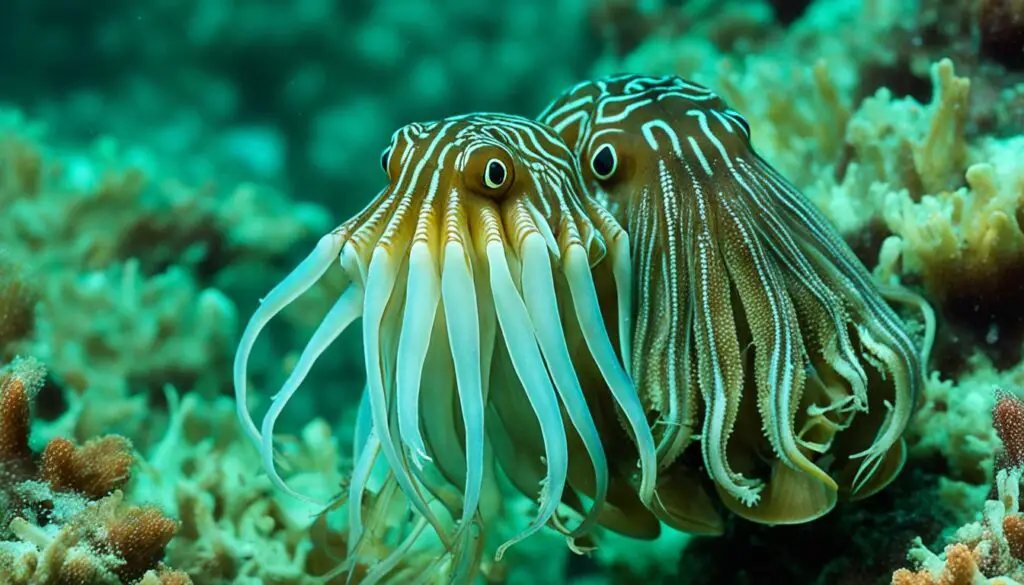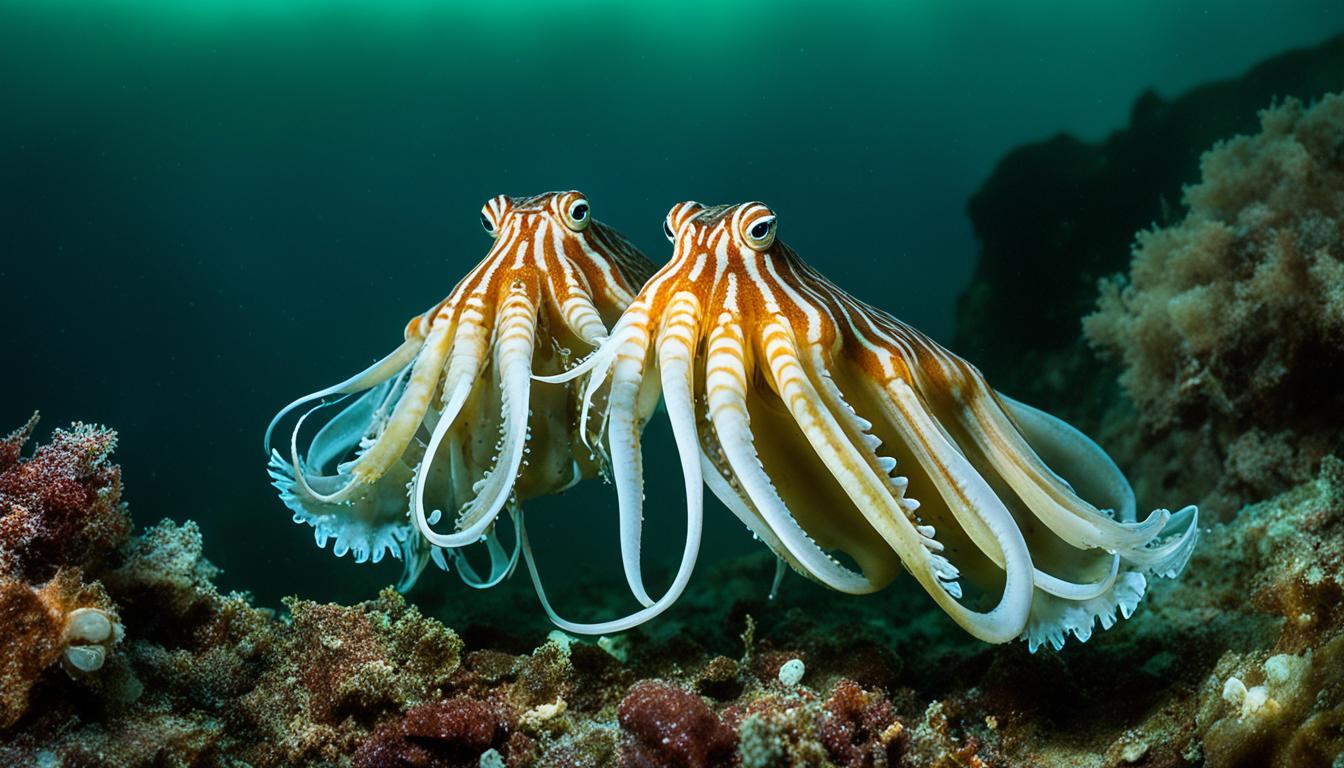Cuttlefish are fascinating creatures with a unique way of reproducing. They have a short life of 12 to 24 months. From January to May, they engage in cuttlefish sexual reproduction. This process includes interesting mating rituals and specific roles for males and females.
Let’s dive into the details of how cuttlefish reproduce. We’ll explore their mating habits and reproductive cycles. This will help us understand their cuttlefish reproductive behavior.
Cuttlefish Reproductive Behavior
Cuttlefish have fascinating ways of reproducing that are both complex and engaging. They use a special mating system where females pick multiple males. This helps increase the genetic diversity of their offspring, which is key for their survival.
Polyandrous Mating Systems
In their mating habits, cuttlefish females often choose to mate with several males. This choice helps them find the best genetic matches for their offspring. It also helps them increase their reproductive success. With many males around, there’s a lot of competition. This competition leads to a clear hierarchy based on dominance and how attractive they are.
Mating Rituals and Courtship Displays
Male cuttlefish show off in vibrant courtship displays during mating. They change color and texture to attract females, even when fighting off other males. These visual signals are crucial in their mating behavior. The brighter the colors, the fitter and more ready the male is to mate.
Gender Differences in Cuttlefish
Gender differences in cuttlefish are quite noticeable. Males are smaller but have more brilliant colors and patterns for mating. Females, on the other hand, have less colorful skin and can turn darker to signal they’re ready to mate. This change in appearance shows how dynamic the cuttlefish breeding process is.
How do cuttlefish reproduce?
The cuttlefish reproduction cycle is fascinating. These cephalopods use a unique strategy. They mainly rely on external fertilization. This method starts when males use a special arm, the hectocotylus, for successful reproduction.
External Fertilization Process
Couples go through complex mating rituals for external fertilization. Females lay their eggs on hard surfaces like coral reefs. This provides a safe place for the embryos to grow.
Males then transfer spermatophores, which are sperm packets, into the female’s mouth. This lets the female control when to fertilize her eggs. It adds flexibility to the timing of reproduction.
Use of Hectocotylus in Reproduction
The hectocotylus is key in cuttlefish reproduction. It’s a modified arm that helps males transfer sperm packets to females. This increases the chances of successful fertilization during the reproductive cycle.
After fertilization, the female attaches the eggs to secure surfaces. This ensures the best conditions for the embryos to grow.
| Aspect | Details |
|---|---|
| Fertilization Type | External |
| Key Structure | Hectocotylus |
| Sperm Storage | Female’s buccal cavity |
| Egg Placement | Coral reefs and hard surfaces |
| Flexibility in Timing | Possible with stored sperm |
Cuttlefish Mating Habits
Cuttlefish have fascinating ways of mating that show their unique approach to reproduction. The process starts with a special position, where the head-to-head stance is key. This stance is vital for the successful transfer of sperm. It also helps in deep communication between males and females, which is crucial for breeding success.
Head-to-Head Mating Position
In this position, males line up right next to females, making it easier to transfer sperm. This setup lets both partners show off their reproductive anatomy in detail. Males often curl their tentacles and show off special colors to show they’re ready to mate.
Communication During Mating
Communication is key during cuttlefish mating, happening through sight and touch. Males change colors to show feelings of aggression or readiness. These color changes, along with touching tentacles, make mating more effective. Learning about these habits shows how complex cuttlefish mating is.

| Type of Communication | Description |
|---|---|
| Color Change | Males display various colors to indicate readiness or aggression. |
| Tentacle Rubbing | Gentle physical contact signaling interest and attraction. |
| Body Posture | Specific positions reflect willingness and dominance. |
Cuttlefish Reproduction Cycle
The cuttlefish reproduction cycle is amazing and depends on the environment. After mating, female cuttlefish lay eggs in a special way. They can lay hundreds of eggs in just a few days, which helps their babies have a better chance to survive.
They lay their eggs in shallow waters near coral reefs. This place is perfect for the eggs to grow. It’s where the babies will start their life journey.
Egg Laying and Nesting Behavior
A female cuttlefish sticks her eggs to things like rocks or seagrass underwater. These places protect the eggs as they grow. This helps the babies have a better chance to make it through their early days.
The place where they lay eggs is very important. It affects how safe the eggs are and if they have enough food to hatch.
Gestation Period and Hatching
The cuttlefish eggs take about 40 days to develop. During this time, you can see the babies moving inside their shells. This shows they are getting ready to be born.
When it’s time, the baby cuttlefish come out. They are about 14 mm long and ready to live on their own. This way, they don’t need much help from their parents after they’re born.
FAQ
How do cuttlefish reproduce?
Cuttlefish reproduce through external fertilization. Males use a special arm called the hectocotylus to put sperm into the female’s body. This allows the female to store the sperm and fertilize her eggs later.
What are the mating habits of cuttlefish?
Cuttlefish have a mating system where females mate with many males. This helps increase the genetic diversity of their offspring. Males show off bright colors to attract females and compete for mating.
What is the role of the hectocotylus in cuttlefish reproduction?
The hectocotylus is a special arm of male cuttlefish. It helps transfer sperm to females during mating. This is key for the fertilization process to happen outside the body.
What is the gestation period for cuttlefish?
Cuttlefish take about 40 days to gestate. The eggs are clear and show the developing babies moving inside before they hatch.
How do cuttlefish communicate during mating rituals?
Cuttlefish use complex ways to communicate during mating. They change colors and body positions to signal. Males show off bright colors to show they’re strong or interested. Females change their skin color to show they’re ready.
Where do female cuttlefish lay their eggs?
Female cuttlefish lay their eggs in shallow water near coral reefs. They stick the eggs to hard surfaces for protection.
What is the size of cuttlefish eggs?
Cuttlefish eggs are about 1.8 to 2 cm wide. Females lay hundreds of these eggs when they breed.
What happens after cuttlefish eggs hatch?
After hatching, baby cuttlefish are around 14 mm long. They can take care of themselves right away. This shows how little parental care cuttlefish have after they reproduce.







